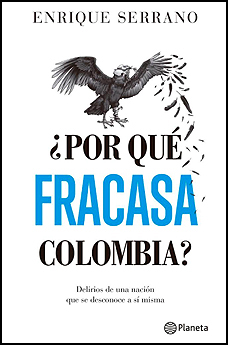[Enrique Serrano, ¿Por qué fracasa Colombia? Delirios de una nación que se desconoce a sí misma, Planeta, Bogotá 2016, 273 pages].
review / María Oliveros [English version] [English version].
Colombia's history has often been classified as one of the most violent. The long chapter of FARC terrorism or the confrontation of drug cartels are well present, but before that there were violent events in Colombia such as the Revolt of the Comuneros, the Thousand Days War or the Banana Plantation Massacre. A succession of events that has led most Colombians to believe that violence has characterized the country's history and that perhaps they can do little to avoid it.
That belief is challenged by Colombian communicator, philosopher and writer Enrique Serrano in ¿Por qué fracasa Colombia? Delusions of a nation that does not know itself. The purpose of the book is to analyze why Colombia has not prospered more as a country. To answer that question, Serrano reviews in short chapters the Colombian mentality since the beginnings of the nation; there he finds reasons why Colombia is a country that has had a hard time getting ahead, growing in progress and being able to develop to the maximum.
 |
¿Por qué fracasa Colombia? is a risky book, which combats thoughts that have long remained in the minds of Colombians. Against that central belief that violence has characterized the country's history, Serrano warns from the very first pages: "It is also presumed that this is a nation plagued by the most vicious violence, from its beginnings to the present day. However, it has been more peaceful than violent, at least during most of its slow training , and although the importance of violence cannot be denied, it is episodic, recent, similar to that of other peoples in transition".
Serrano tries to expose the history of a country that does not begin in 1810 with the independence, but its origins go much further back, to the moment when the Spaniards arrived in America and settled in Colombia. All this in order to show the reader that during the three hundred years that followed the arrival of the first conquistadors, Colombia was a peaceful and measured nation.
Serrano's main premise is that those who arrived in Colombia were mostly new Christians, descendants of Arabs and Jews from southern Spain, who were looking for a provisional place to settle and avoid the religious conflicts that were occurring in Spain at the time. The newcomers settled in small urbanizations, some far from others, not only because that was what the country's geography allowed, but also because the last thing they wanted was to come into conflict with other settlers, both European and indigenous, according to Serrano.
In fact, it is questionable whether the new settlers were dominated by a refractory private religious approach or whether the search for refuge for their consciences motivated, in most cases, their departure to America. It seems that the author adjusts the starting point thinking of those later aspects that he wants to explain.
The author also defends the thesis that in Colombia there was a racial miscegenation, but not a cultural miscegenation, because the indigenous culture was very weak, which contributed to the assumption of the religion brought by the Spaniards. In the culture that the Spaniards transmitted to the new generations were ideas such as provisionality or even getting used to failure: "They also had to react in a peaceful, non-violent way when events were unfavorable and they could not fulfill their desires. Therefore, a relative tolerance and awareness that the frustration of the achievement of desires is something probable, is in the old patterns of upbringing of the Colombian nation".
Serrano suggests that this mentality, which originated centuries ago, is still present in Colombia: the idea of not making the maximum effort, of not taking too many risks for fear of failure, of doing things half-heartedly so as not to lose too much in case they go wrong. This mentality that was created over the years probably explains why urbanization projects in the country do not progress properly, why the subway project in the Colombian capital has not been able to materialize, or why it has cost the country so much to exploit its resources to the maximum.
Although the book touches on other aspects such as language, body hygiene and social classes, history is undoubtedly the fundamental component. Referring to historical events of the Colombian past, Serrano proposes a vision of national history far from the usual one. Thus, as has been said, his story does not begin with the cry for independence of 1810, but explains the Spanish society of the 15th and 16th centuries, in order to understand the mentality of the first men, women and families who arrived in America. It is an optimistic vision that seeks to share the idea that not everything has been suffering in Colombian history.
It is a fact that the country's history is not lived or remembered with much enthusiasm by Colombians. Remembering the past is for many a way of recalling the violence, wars and national polarization that began with the training of the two major parties, Liberals and Conservatives, in the mid-nineteenth century. Knowing the past well, in any case, is paramount for progress; that is what the new law enacted on January 1, 2018, which requires all schools in the country to teach Colombian history class , seeks to do.
The book concludes with a series of suggestions about the present and the future. The last chapter, graduate Where can such a nation go, tries to transmit a feeling of hope, while at the same time it is a call to high responsibility. According to the author, knowing the past and not running away from it, but accepting it in order to improve mentalities and habits, is what will give the country the basis for not failing.